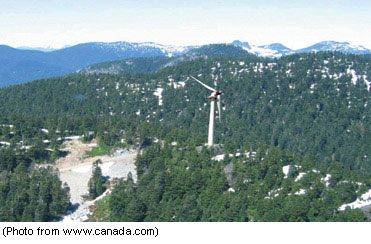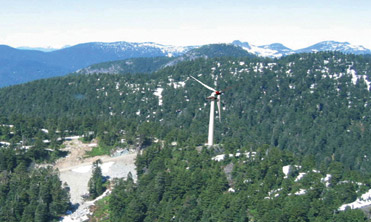

Wind Turbine Making a Noise in Vancouver
GLOBE-Net
October 20, 2008
A 65-meter high wind turbine will be built on the grounds of Grouse Mountain, a ski resort in the District of North Vancouver in British Columbia. The split-vote approval by the North Vancouver Districtís council on October 6th came after a heated debate between those who approve green initiatives and those who fear the turbinesí swirling long blades will harm the environment.
Grouse Mountain is one of Vancouverís most popular destinations. Its ski slopes can be seen from almost anywhere in the cityís downtown core. Tourists flock to the resortís aerial tramway that whisks them to the snow-covered mountains in less than 10 minutes during winter months. Visitors can paraglide or watch a lumberjack show while hikers walk on backcountry trails in the summer.
Yet success comes at a price. With so many tourists vying for access to nature, Grouse Mountain requires increasing amounts of electricity to operate chairlifts, power kitchens, illuminate its chalet and flood the slopes with light during night-time skiing. The resortís carbon footprint can only be reduced with an alternative approach: Its planned wind turbine, with a capacity of 1.5 megawatts, is expected to generate one fifth of the resortís electricity needs once operating at full capacity in 2010, just in time for the Winter Olympic Games.
The 21-storey structure - 34 stories if you measure to the top of the blade -- will stand at the top of Peak Mountain, right next to two chairlifts. It will be located in a windy corridor and its white blades will blend with the sky, according to the company proposal. A viewing platform for 24 people will hover 58 meters above ground. Naturally, standing alone on a mountain peak, the wind turbine will be visible for miles around.
 |
"Why are we doing this? Not only is it for sustainable energy purposes, I think itís also for another tourist attraction," says District of North Vancouver Councilor Janice Harris who strongly opposed the project during the heated debate approval process.
She adds that the turbine presents a "clear and present danger to bats" that internally hemorrhage near the structures due to the sudden drop in wind pressure. "My concern is the environmental impact canít be quantified or known at this stage," she adds in the North Shore News, a local weekly newspaper.
Grouse Mountain Resorts, which operates the tourist facility, argues that it has secured an environmental study of the local wildlife. The potential impact on the habitat loss and disturbance of bats is "negligible," according to its author. Birds, on the other hand, might be killed by the blades on low-cloud or foggy days, a common occurrence in southwestern British Columbia.
Residents who live at the bottom of the mountain also worry about the noise the blade will make as it spins for days on end. Yet, according to Grouse Mountain Resorts, the whooshing sound will be inaudible beyond its property boundaries. Besides, it argues, the sounds at the base of the turbine will not be louder than a car driving through a residential neighborhood.
The controversial turbine is part of a renewed interest in wind-generated power in Canada. Today this renewable energy process powers the equivalent of 563,000 homes in the country, according to the Canadian Wind Energy Association. If Canada used its untapped wind resources it might be able to provide 20 percent of its electrical needs, enough to power 17 million homes.
Yet issues remain. When wind turbines are built in remote areas they often get often a free pass on their environmental risks, but when they pop up near human settlements, residents raise concerns. On the one hand people want technology that reduces the countryís reliance on fossil fuels. On the other they cling to a "Not in My Backyard" mentality that wants to protect the landscape and in the case of wind turbines the lives of migrating birds. This duality amplifies the fact that saving the environment is rarely a zero-sum game.
This is why the wind turbine on top of Grouse Mountain comes as a double-edged sword. The resort will gain publicity for its environmentally-friendly posture but this stand will remind everyone that a price needs to be paid to save the planet. Unfortunately for the resort, it might find itself in the middle of a green controversy for years to come.
For More Information: Grouse Mountain
DNV council approves wind turbine for Grouse
Hollie LatulippeNorth Shore News
Wednesday, October 08, 2008
 A computerized image illustrates the height of the wind turbine planned for near the peak of Grouse Mountain. The turbine will generate 20 per cent of the resort's power needs.
CREDIT: photo illustration supplied
A computerized image illustrates the height of the wind turbine planned for near the peak of Grouse Mountain. The turbine will generate 20 per cent of the resort's power needs.
CREDIT: photo illustration supplied |
A split vote after a lengthy debate Monday night saw District of North Vancouver council agree to issue the development permit for a 65-metre wind turbine near the peak of Grouse Mountain.
The 21-storey white tower, which will be visible to much of North Vancouver, is expected to generate a fifth of Grouse Mountain Resort's energy. It will be a leading example for future green-energy initiatives, said Mayor Richard Walton.
But several council members were concerned about the turbine's impact on wildlife and its visual impact on the skyline. The vote eventually passed 4-3, after Coun. Lisa Muri's motion to defer the decision failed.
John Williamson, a North Vancouver resident who lives within view of Grouse Mountain, said he wasn't aware of the turbine proposal until last weekend. "To date, I still believe people are not aware of this project," he said.
Williamson said he has seen wind turbines during his travels in Europe, and they look like "giant aliens" to him. He said he is also concerned about the turbine's impact on birds.
Stuart McLaughlin, president of Grouse Mountain Resorts, said the majority of the 25 people who attended the Sept. 4 public information meeting were satisfied with plans for the turbine.
As for its environmental impact, "you won't build anything in the district without an impact on birds and bats," he said.
Grouse has worked closely with district staff, and the development permit was made known to the public four months ago, he added.
Coun. Janice Harris said she is strongly opposed to the project.
"My concern is the environmental impact can't be quantified or known at this stage," she said.
And the turbine is a "clear and present danger to bats," who internally hemorrhage near the structures due to the sudden drop in wind pressure, said Harris.
She was also concerned about the noise of the turbine, saying it will be another "low-level constant sound" on the mountain. "Why are we doing this? Not only is it for sustainable energy purposes, I think it's also for another tourist attraction."
Muri said she received many e-mails of concern from the public after a story about the wind turbine proposal was published in the North Shore News on Sunday.
"That triggers something in me as a council member, that maybe we didn't go as far as we should have," she said.
"The visual impact, I don't know if it's that high up on the radar. Yet the e-mails received, mostly today, show a huge concern over loss of the skyline."
Coun. Alan Nixon said the risk to birds and bats was too great for the project to receive his support.
"At what point do we as a society say it's OK to go ahead with these things? We've got to start developing, in my opinion, almost zero tolerance when it can be proven to us bats are suffering mortality as a result."
But the mayor said the district needs to "take some risks and we have to take some leadership."
"I spend most of my available time in the bush," he said. "I spend a lot of time paying attention to making sure these spaces are preserved. I take comfort the very first issues Grouse Mountain brought to us as council were about the environmental concerns."
Coun. Mike Little said the turbine is an excellent project, and once erected, people will notice it for "about two weeks, and then it will just disappear into the horizon."
The vote passed with Harris, Muri and Nixon opposed.
McLaughlin said the turbine should be up and running for the 2010 Olympics.
© North Shore News 2008